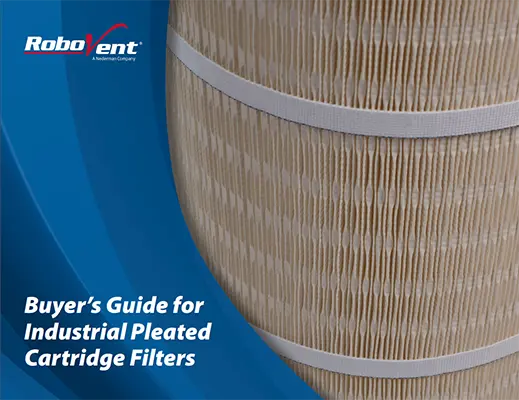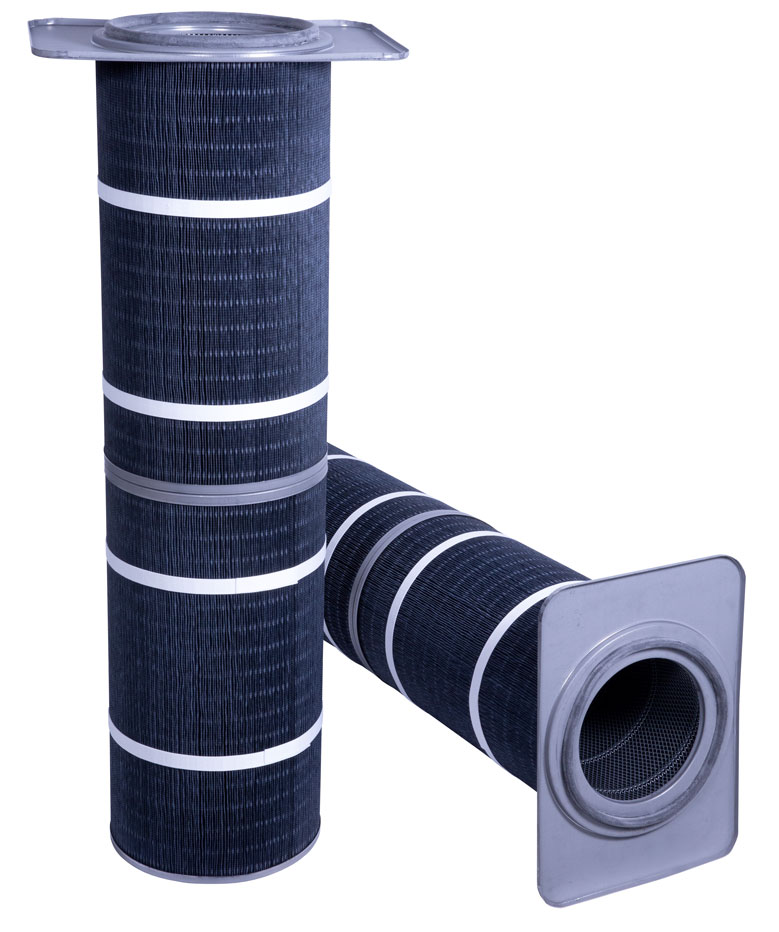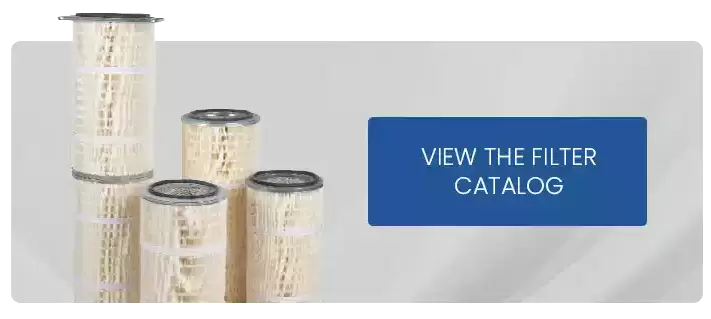Understanding Filtration Efficiency: Filter Selection Guide
What is filtration efficiency, and why should you care? Understanding filtration efficiency will help you pick out the right filters for dust collection, industrial air filtration and HVAC applications. From MERV ratings to molecular filtration, this guide provides the information necessary to make an informed decision in meeting air quality needs.
Filtration Efficiency Basics: MERV, HEPA and ULPA Filters
For air filters, including industrial air filters and HVAC filters, filtration efficiency refers to the ability of a filter to capture airborne contaminants and particulate circulating in the air. It is a measure of how well the filter can capture and retain particles or pollutants of certain sizes and types compared to the amount that passes through the filter. Filtration efficiency is typically expressed as a percentage, indicating the proportion of the targeted particles or contaminants that the filter successfully removes from the medium. For air filtration of dry particulate, important ratings to understand include the MERV rating system, HEPA and ULPA. Gases and vapors will require some form of molecular filtration.
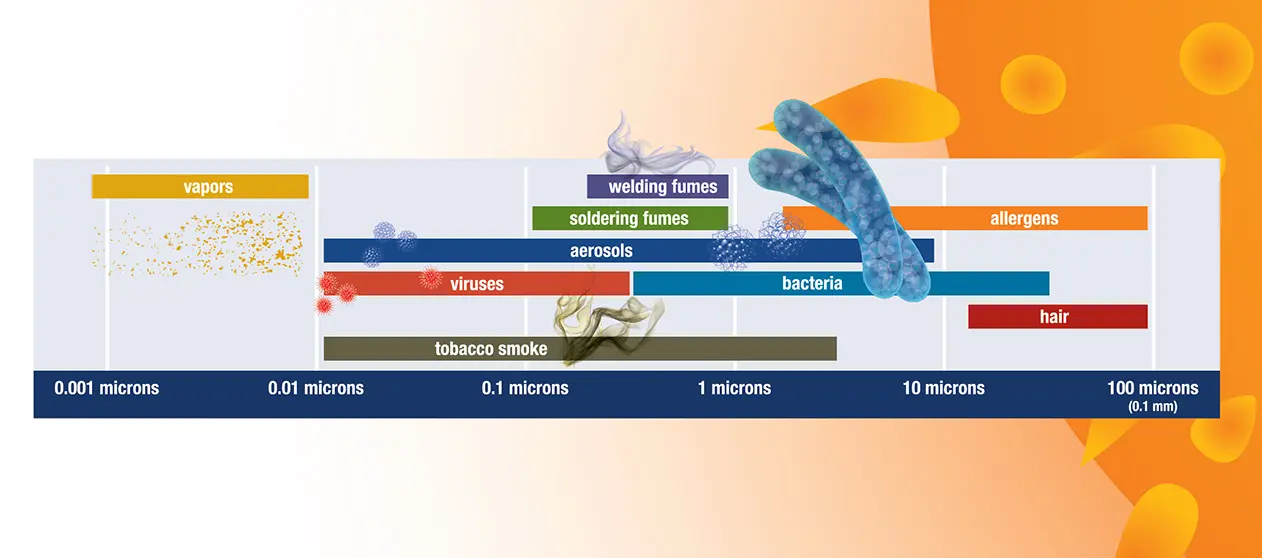
MERV Rating System
MERV (Medium Efficiency Reporting Value) ratings follow a scale from 1 to 16, with 1 being the least efficient and 16 assigned to the filter with the highest efficiency. (Some charts show MERV ratings up to 20, with MERV ratings of 17-20 being equivalent to HEPA or ULPA filters.) Developed by the American Society of Heating, Refrigerating and Air Conditioning Engineers (ASHRAE), this rating system helps end-users understand filter efficiency for dry particulate air filters only. For industrial air filtration and cartridge dust collectors, filters with MERV ratings of 10 or higher are usually recommended.
MERV ratings are based on the percentage of particulate a filter can capture in three size bands: 3.0 – 10.0 microns, 1.0 – 3.0 microns, and 0.30 – 1.0 microns.
- The lowest efficiency MERV filters, which are classified as MERV 1-4, are made to capture large particles. These will capture less than 20 percent of particles from 3.0 to 10 microns. Filters with this level of efficiency are most often found in window air conditioning units or as a pre-filtration layer in commercial or residential HVAC systems.
- MERV 5-9 filters offer better filtration efficiency for use in light commercial applications and in residential HVAC systems.
- MERV 10-13 filters are used in manufacturing facilities, commercial kitchens, data centers, and in museums and archives to protect sensitive/historical items. They can manage metal dust generated in grinding and cutting applications and other general dust created by industrial applications.
- MERV 14-16 filters are used in environments where superior air quality is required, including hospitals and labs (except where true cleanroom conditions are required). They are efficient in capturing particulate from various chemical powders and for collection of weld fume and laser cutting dust.
| MERV Rating | Capture Rate by Particle Size Microns | Smallest Particle Types | Applications |
|---|---|---|---|
| 1-4 | 3.0 - 10.0 less than 20% | Pollen Dust Mites Sanding Dust/Sawdust Textile Fibers | Window Air Conditioning Units Pre-Filtration Residential furnace filters |
| 5 | 3.0-10.0 greater than or equal to 20% | Dust/lint Mold spores Cement dust | Pre-filtration HVAC (commercial buildings, better residential filters) Paint booth inlets General/non-hazardous dust collection for industry (e.g., sawdust) |
| 6 | 3.0-10.0 greater than or equal to 35% | Dust/lint Mold spores Cement dust | Pre-filtration HVAC (commercial buildings, better residential filters) Paint booth inlets General/non-hazardous dust collection for industry (e.g., sawdust) |
| 7 | 3.0-10.0 greater than or equal to 50% | Dust/lint Mold spores Cement dust | Pre-filtration HVAC (commercial buildings, better residential filters) Paint booth inlets General/non-hazardous dust collection for industry (e.g., sawdust) |
| 8 | 1.0-3.0 greater than or equal to 20% 3.0-10.0 greater than or equal to 70% | Dust/lint Mold spores Cement dust | Pre-filtration HVAC (commercial buildings, better residential filters) Paint booth inlets General/non-hazardous dust collection for industry (e.g., sawdust) |
| 9 | 1.0-3.0 greater than or equal to 35% 3.0-10.0 greater than or equal to 75% | Dust/lint Mold spores Cement dust | Pre-filtration HVAC (commercial buildings, better residential filters) Paint booth inlets General/non-hazardous dust collection for industry (e.g., sawdust) |
| 10 | 1.0-3.0 greater than or equal to 50% 3.0-10.0 greater than or equal to 80% | Legionella Lead dust Humidifier or nebulizer dust Coal dust | Industrial dust collection, general (e.g., cartridge and baghouse dust collector filters) HVAC (better commercial buildings, hospitals and laboratories) |
| 11 | 0.30-1.0 greater than or equal to 20% 1.0-3.0 greater than or equal to 65% 3.0-10.0 greater than or equal to 85% | Legionella Lead dust Humidifier or nebulizer dust Coal dust | Industrial dust collection, general (e.g., cartridge and baghouse dust collector filters) HVAC (better commercial buildings, hospitals and laboratories) |
| 12 | 0.30-1.0 greater than or equal to 35% 1.0-3.0 greater than or equal to 80% 3.0-10.0 greater than or equal to 90% | Legionella Lead dust Humidifier or nebulizer dust Coal dust | Industrial dust collection, general (e.g., cartridge and baghouse dust collector filters) HVAC (better commercial buildings, hospitals and laboratories) |
| 13 | 0.30-1.0 greater than or equal to 50% 1.0-3.0 greater than or equal to 85% 3.0-10.0 greater than or equal to 90% | Bacteria Tobacco smoke Weld smoke/fume Auto fumes Copier toner Pet dander Face powder | Industrial dust collection (fine or hazardous particulate) Weld fume collection Surgical centers and hospital rooms Smoking lounges |
| 14 | 0.30-1.0 greater than or equal to 75% 1.0-3.0 greater than or equal to 90% 3.0-10.0 greater than or equal to 95% | Bacteria Tobacco smoke Weld smoke/fume Auto fumes Copier toner Pet dander Face powder | Industrial dust collection (fine or hazardous particulate) Weld fume collection Surgical centers and hospital rooms Smoking lounges |
| 15 | 0.30-1.0 greater than or equal to 85% 1.0-3.0 greater than or equal to 90% 3.0-10.0 greater than or equal to 95% | Bacteria Tobacco smoke Weld smoke/fume Auto fumes Copier toner Pet dander Face powder | Industrial dust collection (fine or hazardous particulate) Weld fume collection Surgical centers and hospital rooms Smoking lounges |
| 16 | 0.30-1.0 greater than or equal to 95% 1.0-3.0 greater than or equal to 95% 3.0-10.0 greater than or equal to 95% | Bacteria Tobacco smoke Weld smoke/fume Auto fumes Copier toner Pet dander Face powder | Industrial dust collection (fine or hazardous particulate) Weld fume collection Surgical centers and hospital rooms Smoking lounges |
| High efficiency Particulate Air filter HEPA* | 99.97% of particles in the 0.3-micron range Particles that are larger or smaller than 0.3 microns are captured with a greater than 99.97% efficiency | Nanomaterials Viral carriers and larger viruses Carbon dust/ graphite powder Combustion smoke Odors | After-filters in dust collection Laboratory cleanrooms Pharmaceutical manufacturing Electronics manufacturing Data centers Carcinogenic or highly toxic materials Portable air purifiers |
Source: U.S. EPA: https://www.epa.gov/indoor-air-quality-iaq/what-merv-rating
To establish how filters are assigned MERV ratings, they are tested under ASHRAE Standard 52.2. This involves controlled conditions where the filters are subjected to particles of different sizes and within various concentrations. The particles are counted before and after they enter the filter. The ratio of particles captured establishes the efficiency of the filter. To ensure the accuracy of the testing, the process is repeated in different conditions.
Are MERV 16 and HEPA filters equal in their ability to capture small particles? There are similarities, such as their use in healthcare facilities and other spaces where clean air is a necessity, but there are some distinct differences:
- MERV 16 filters capture at least 95 percent of particles as small as 0.3 micrometers, whereas HEPA filters capture at least 99.97 percent of particles sized 0.3 micrometers.
- Because HEPA filters are considered the “gold standard” in capturing particles related to bacteria, viruses and allergens, HEPA filters are used more often in areas where the highest level of air purity is required, including in spaces for electronics manufacturing, pharmaceutical manufacturing, medical settings and in cleanrooms.
HEPA Filters
HEPA (High-Efficiency Particulate Air) filters meet a standard set by the U.S. Department of Energy, which is that they capture at least 99.97 percent of particles size 0.3 micrometers (microns) or larger. Substances this small include fine carbon and graphite dust, certain chemical powders, smaller bacteria, viruses and viral carriers, fumed particulates, and smaller combustion particles from engines and smoking. Their efficiency at capturing fine particles makes HEPA filters among the most efficient on the market today. HEPA filters must undergo testing under EN 1822 and ISO 29463.
The following are the most common uses of HEPA filters:
- Data centers where the filter prevents the accumulation of dust and other particles that can negatively impact electronic equipment.
- Manufacturing facilities for industries that produce electronics, optical equipment, and precision parts.
- Pharmaceutical manufacturing to ensure a contamination-free environment for the production of medications and nutraceuticals.
- Battery manufacturing facilities, especially those handling nanomaterials.
- Residential and commercial air purifiers, providing cleaner air free of pollutants and allergens.
- Research laboratory cleanrooms, including biosafety cleanrooms.
- Cabin air filtration systems for aircraft and automobiles.
- Operating rooms, isolation rooms and medical laboratories where sterile environments are a crucial safety requirement.
- Vacuum cleaners, including commercial vacuums used in hotels, office buildings and other commercial facilities, controlling the release of dust mites, pet dander and other allergens.
ULPA Filters
ULPA (Ultra-Low Penetration Air) filters are designed to capture exceedingly small particles at a highly efficient rate. ULPA filters are built to remove at least 99.999 percent of particles sized 0.12 micrometers or larger. When the smallest particles in the air will have a negative impact on product quality or human health, an ULPA filter may be recommended. Like HEPA filters, ULPA filters are tested under EN 1822 and ISO 29463.
ULPA filters are used most commonly in the following environments:
- Laboratories where nanotechnology research involves working with small particles.
- Biological labs and biological safety cabinets where research at the molecular level occurs.
- Semiconductor and microelectronics manufacturing.
Molecular Filtration (Activated Carbon)
HEPA and ULPA filters are designed for capturing dry particulate, but not for situations where gas-phase and vapor emissions are present, such as volatile organic compounds (VOCs). Rather, molecular filtration is needed to remove gaseous emissions, odors and vapors. The most common molecular filtration technology is activated carbon.
A dry particle filter utilizes fibrous material that captures dry substances. Even at its highest levels of efficiency, MERV filters are not capable of molecular filtration, which is what is required for control of gas-phase emissions. Gases and most vapors simply pass through the fibers in HEPA and MERV filters.
Molecular filtration is accomplished either with a membrane system or by using an adsorptive material (most commonly carbon), which captures molecules through either chemical or physical bonding. Activated carbon is a highly porous form of carbon filled with microscopic nanopores that provide a higher surface area for adsorption.
Another unique quality of activated carbon filters is that they are capable of controlling odors. The technology relies on a highly porous surface that can adsorb gases, VOCs and odorous substances. This means that when air is released from the system, it is not only free of pollutants, but it also has no odor.
Common applications for the activated carbon filters in air filtration include the following:
- Chemical manufacturing facilities where activated carbon filters are used to comply with environmental regulations regarding volatile chemical emission control.
- Paint and coating operations where coatings, paints and adhesive VOCs require molecular filtration solutions.
- Pharmaceutical manufacturing for filtering VOCs released by solvents.
- Food and beverage processing facilities for preventing unpleasant tastes/odors in the finished product.
- Removing toxic gases and emissions from industrial processes.
- Use in certain types of respiratory masks.
Choosing the Right Filtration Efficiency
Choosing the right air filter for air filtration involves a variety of considerations. These include:
- The size of the particulate that must be collected.
- The filtration efficiency (percentage of particulate captured) that must be maintained based on the hazard level of the particulate, application cleanliness requirements, relevant standards and other considerations.
- Relevant codes, regulations and standards for indoor air quality, emissions, and permissible exposure limits (PELs).
- Budget and operating costs and maintenance considerations.
Standards and Regulations for Filtration Efficiency
The most important criteria for choosing the right filtration efficiency are the size of the particulate that must be collected and how clean the air must be after it passes through the filter. Relevant standards for air filtration include:
- ASHRAE Standard 62.1: “Ventilation for Acceptable Indoor Air Quality” is one of the most widely referenced standards for ventilation and IAQ in commercial and institutional buildings. It specifies minimum ventilation rates and other measures intended to minimize adverse health effects for occupants. ASHRAE 62.1 includes guidelines on the selection of filters with adequate MERV ratings (Minimum Efficiency Reporting Value) to effectively remove pollutants from indoor air.
- OSHA PELs: The Occupational Safety and Health Administration (OSHA) has established Permissible Exposure Limits (PELs) for numerous airborne contaminants, including chemicals and particulates, applicable to workplace environments. These limits are designed to protect workers from adverse health effects due to exposure to hazardous substances.
- EPA Indoor Air Quality Guidelines: The U.S. Environmental Protection Agency (EPA) provides guidelines and resources for managing IAQ, including levels for various indoor air pollutants. While the EPA does not set enforceable standards for IAQ, it offers valuable information on best practices and recommendations.
- EPA Clean Air Act: The U.S. Environmental Protection Agency (EPA) emissions standards are designed to regulate and reduce air pollutants from various sources, including industrial facilities, to protect public health and the environment. These standards cover a wide range of pollutants. In industrial air filtration applications that vent air to the outside, filters must be selected to meet EPA emissions regulations.
Filtration Efficiency, Pressure Drop and Energy Costs
When choosing air filters for HVAC systems, industrial air filtration and other applications, it is important to understand the tradeoffs between filtration efficiency and energy use. High-efficiency filters are more resistant to airflow, resulting in higher pressure drop across the filter. That means it takes more energy to push air through the filters and maintain airflow. High-efficiency filters will capture more airborne particles than low-efficiency filters, but the pressure drop leads to higher energy usage for achieving appropriate rates of airflow.
HVAC Applications
The recommended filtration efficiency for HVAC systems depends on the facility type and the indoor air quality goals. Different scenarios require different filter types.
- In a residential setting, for instance, MERV 8 to 13 filters offer a good balance of airflow to filtration efficiency, effectively capturing typical household allergens and general dust.
- Similarly, in commercial facilities, such as office buildings and retail spaces where common indoor pollutants are present, MERV 8 to 13 filters provide suitable efficiency.
- When capturing finer contaminants at a higher ratio is vital, which is the case in industrial settings where stricter controls are mandatory, MERV 11 to 16 filters are recommended.
- Healthcare facilities and laboratories also often call for cleaner air solutions, which is where HEPA and MERV 14 to 16 filters are the go-to options.
Should HEPA filters be used for HVAC applications?
The following are the pros and cons of high-efficiency HVAC filters:
- High-efficiency filters capture smaller particles and can reduce health risks, but the HVAC system works harder to move air, leading to higher utility costs.
- Meeting indoor air quality standards may require the use of high-efficiency HVAC filters, but these filters are more costly than low-efficiency filters.
- HVAC equipment, such as coils and fans, are protected from the accumulation of particles when high-efficiency filters are used, but the system must be designed to accommodate the use of these filters, which includes utilizing more powerful fans and larger ducts.
If using high efficiency filters for HVAC applications, these filters will hold more particulate and have to be replaced more often. Since these filters are also expensive, it is often advisable to use a cheap pre-filter in front of the HEPA filter to protect it and extend its life.
In industrial settings, the HVAC system should not be the first line of defense against indoor pollutants. A dust collection system with high-efficiency filters is more effective and efficient than relying on the HVAC system to remove contaminants.
Configurations for HVAC Filters
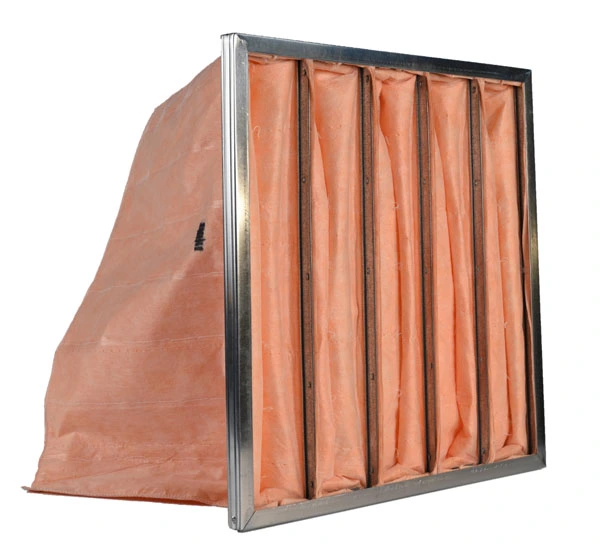
Just as there are different efficiencies in the design of various filters, they are also manufactured in different configurations and sizes. It is very important to choose a filter sized and configured for your HVAC system. Common configurations for HVAC filters include:
- Flat panel filters, a basic type of air filter used in residential and commercial HVAC systems typically constructed from a spun fiberglass material or from pleated paper or cloth encased in a cardboard frame.
- Pleated panel filters, which are similar to flat panel filters, maximize the filter’s surface area and are used in residential and commercial HVAC systems.
- Electrostatic filters contain fibers or parallel plates that are charged to attract and capture particles. They offer better filtration than flat panel filters and are also used in residential and commercial HVAC systems.
- Pleated box filters are built with either a cardboard or metal frame and offer high filtration efficiency because of the increased surface area. These are found in light commercial applications.
Industrial Ventilation and Air Filtration
Matching a filter to your industrial needs requires consideration of numerous variables, including the size of the dust particles being captured, the toxicity of the particles and application cleanliness requirements. Various clean air standards provide guidance that will inform decisions made about implementing industrial ventilation and air filtration filters. Filtration efficiency for industrial air filters should be selected based on the cleanliness requirements of the application and relevant indoor air quality standards, including any applicable OSHA PELs.
Types of Industrial Air Filters
Two popular varieties for industrial uses include cartridge filters and baghouse filters.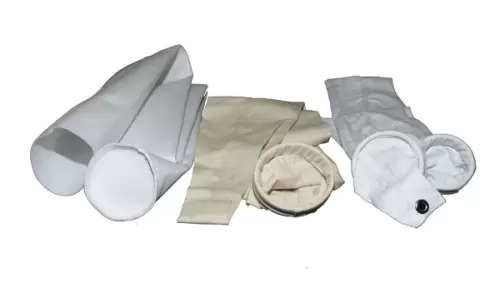
- Baghouse systems use large fabric filters that may be shaped like an envelope or a sock. Rather than follow a MERV rating, baghouse filters (or fabric filters) are classified by their efficiency based on the bag’s material composition and the number of layers.
- Cartridge filters are cylindrical designed to capture and remove fine airborne particles. They are used in cartridge-style industrial dust collectors. The pleated design of these filters offers better filtration efficiency and a more compact design, which allows for a smaller dust collection system. Cartridge filters are rated using the MERV rating system and come in MERV ratings from 10-16.
- After-filters: Cartridge dust collectors can also be equipped with HEPA or activated carbon after-filters for applications requiring high-efficiency filtration or control of gaseous emissions and odors.
- Paint/Spray Booth Filters: Paint and spray booths may require different types of filters, including pre-filters, overspray exhaust filters, intake filters and ceiling diffusion media.
Learn more: Baghouse vs. Cartridge Filters
Find the Best Air Filters at RoboVent
RoboVent manufactures a wide selection of cartridge dust collector filters for use in practically any application. From basic cartridge air filters for general dust collection all the way up to MERV 16 and HEPA high-efficiency filters for achieving maximum air quality, there are many options from which to choose. RoboVent also offers other types of filters, including baghouse, HVAC filters, panel filters, paint/spray booth and compressed air filters.
For more information about choosing the best filter for your specific needs, contact us and talk to one of our filter experts.
Contact Us With Your Questions!
SUBSCRIBE TO
BLOG UPDATES


